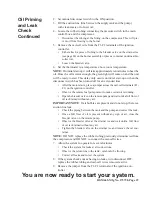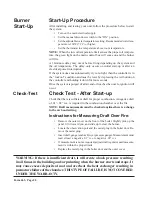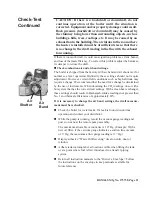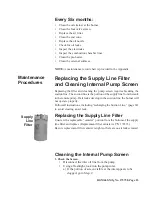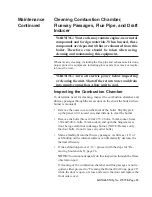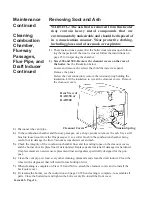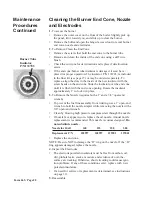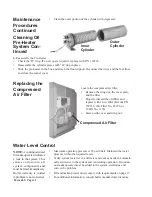
Form 465, Page 20
Check-Test
Check Test - After Start-up
Check that there is sufficient draft for proper combustion. A negative draft
of .01”-.02” w.c. is required in the combustion chamber over the fire.
NOTE: Draft measurements must be checked anytime there is a change
in the air band setting.
Instructions for Measuring Draft Over Fire:
•
Remove the outer cover on the front of the boiler. Slightly pick up the
panel, tilt it toward you, and slide up to clear the burner.
•
Locate the observation port and the metal plug in the boiler door. Re-
move the metal plug.
•
Insert draft gauge (such as Dwyer pressure gauge). Measurement must
read at least a negative .01” w.c. to negative .02” w.c.
•
If measurement is not as required, adjust draft regulator until measure-
ment is within the proper limits.
•
Replace the metal plug in the boiler door and the outer cover.
Burner
Start-Up
Start-Up Procedure
After installing and testing your unit, follow the procedure below to start
the system.
•
Turn on the main electrical supply.
•
Set the manual disconnect switch to the “ON” position.
•
Set the adjustable water temperature setting. Recommended water tem-
perature is 160
o
F (71
o
C) or higher.
•
Set the thermostat to a temperature above room temperature.
NOTE:
When the low oil temperature limit senses the proper oil tempera-
ture, the green light on the main control box will come on and the burner
will fire.
A 10-minute delay may occur before firing depending on the system and
the oil temperature. The delay only occurs on initial start-up or after an
electrical power interruption.
If the system does not automatically try to re-light, then the controller is in
the “lockout” condition and must be reset by depressing the red button on
the controller and holding it down for four seconds.
Once the system is purged of all air and oil reaches the nozzle, ignition will
occur.
WARNING: If there is insufficient draft, it will create a back pressure resulting
in oil fumes in the building and/or pulsating when the burner starts and stops. It
may cause excess deposits of soot and overheat the heat exchanger resulting in
premature failure of the chamber. THIS TYPE OF FAILURE IS NOT COVERED
UNDER THE WARRANTY.














